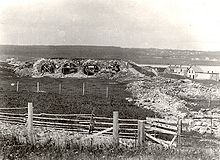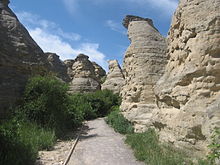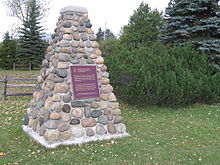- National Historic Sites of Canada
-
 Fort Howe in Saint John, New Brunswick; its designation as a National Historic Park in 1914 marked the beginning of the emerging system of National Historic Sites
Fort Howe in Saint John, New Brunswick; its designation as a National Historic Park in 1914 marked the beginning of the emerging system of National Historic Sites
National Historic Sites of Canada (French: Lieux historiques nationaux du Canada) are places that have been designated by the Minister of the Environment of Canada, on the advice of the Historic Sites and Monuments Board of Canada (HSMB), as being of national historic significance.[1][2] Parks Canada, a federal agency, manages the National Historic Sites program. As of August 2010, there are 956 National Historic Sites of Canada,[3] of which 167 are administered by Parks Canada; the remainder are administered and/or owned by other levels of government or private entities.[4] The sites are located across all ten provinces and three territories, with two sites located in France (the Beaumont-Hamel Newfoundland Memorial and Canadian National Vimy Memorial).[5]
Canada has related programs for the designation of Persons of National Historic Significance and Events of National Historic Significance.[6]
Contents
History
Early developments
 The celebrations of Quebec City's tricentennial in 1908 acted as a catalyst for federal efforts to designate and preserve historic sites.
The celebrations of Quebec City's tricentennial in 1908 acted as a catalyst for federal efforts to designate and preserve historic sites.
Emerging Canadian nationalist sentiment in the late 19th century and early 20th century led to an increased interest in preserving Canada's historic sites.[7] The 1908 tricentennial of the founding of Quebec City, and the establishment that same year of the National Battlefields Commission to preserve the Plains of Abraham, acted as a catalyst for federal efforts to designate and preserve historic sites across Canada.[8] At the same time, the federal government was looking for ways to extend the National Parks system into Eastern Canada.[7] The more populated east did not have the same large expanses of undeveloped federal Crown land that had become parks in the west, so the Dominion Parks Branch (the predecessor to Parks Canada) looked to historic features to act as focal points for new national parks. In 1914, the Parks Branch undertook a survey of historic sites in Canada, although the objective of the exercise was on creating new recreational areas rather than preserving historic places. Fort Howe in Saint John, New Brunswick was designated a National Historic Park in 1914. Fort Howe was not a site of significant national historic importance, but its designation provided a rationale for the acquisition of land for a park. Fort Anne in Annapolis Royal, Nova Scotia was similarly designated in 1917.[9]
In 1919, William James Roche, the Minister of the Interior, was concerned over the fate of old fur trade posts in Western Canada, and he was also being lobbied by historical associations across Canada for federal funds to assist with the preservation and commemoration of local landmarks. At the same time, the Department of Militia and Defence was anxious to transfer old forts, and the associated expenses, to the Parks Branch. Roche asked James B. Harkin, the first Commissioner of Dominion Parks, to develop a departmental heritage policy. Harkin believed that the Parks Branch did not have the necessary expertise to manage historic resources; he was troubled by the relatively weak historic value of Fort Howe, the country's first historic park, and feared that the Branch's park improvements were incompatible with the heritage attributes of Fort Anne, the second historic park.[10]
Historic Sites and Monuments Board of Canada
 The initial focus of the program was strictly on commemoration rather than preservation or restoration. The ruins of the Fortress of Louisbourg were designated in 1920, but efforts to restore the fortress did not commence until 1961.[11]
The initial focus of the program was strictly on commemoration rather than preservation or restoration. The ruins of the Fortress of Louisbourg were designated in 1920, but efforts to restore the fortress did not commence until 1961.[11]
On Harkin's recommendation, the government created the Advisory Board for Historic Site Preservation (later called the Historic Sites and Monuments Board of Canada) in 1919 in order to advise the Minister on a new program of National Historic Sites.[7] Brigadier General Ernest Alexander Cruikshank, a noted authority on the War of 1812 and the history of Ontario, was chosen as the Board's first chairman, a post he held for twenty years.[12] The first place designated and plaqued under the new program was the "Cliff Site" in Port Dover, Ontario, where two priests claimed sovereignty over the Lake Erie region for Louis XIV of France in 1670.[13]
Due to a lack of resources, the HSMBC limited itself to recommending sites for designation, and the focus of the program was on commemoration rather than on preservation. Benjamin Sulte, a member of the HSMBC, wrote to Harkin in 1919 about the significant ruins at the Forges du Saint-Maurice, demonstrating his preference for the installation of a plaque over restoration: "All that can be done in our days is to clear away the heap of stones, in order to reach the foundation walls and plant a sign in the centre of the square thus uncovered."[14]
In the early years of the program, National Historic Sites were chosen to commemorate battles, important men, the fur trade and political events; the focus was on the "great men and events" credited with establishing the nation.[8][15] Of the 285 National Historic Sites designated by 1943, 105 represented military history, 52 represented the fur trade and exploration, and 43 represented famous individuals (almost entirely men). There was also a strong bias in favour of commemorating sites in Ontario over other parts of the country (with some members of the HSMBC even concluding at one time that there were no sites at all in Prince Edward Island worthy of designation). The then prominence of sites in Ontario related to the War of 1812 and the United Empire Loyalists has been attributed to the influence of Cruikshank, resulting in a "veritable palisade of historical markers along the St. Lawrence" commemorating the resistance to Americanism. Proposals to designate sites related to the immigration of Jews, Blacks and Ukrainians to Canada were rejected.[16][17]
Evolution of the program
 Áísínai’pi, a location of significant cultural and religious importance to the Blackfoot people, was designated in 2006.[18]
Áísínai’pi, a location of significant cultural and religious importance to the Blackfoot people, was designated in 2006.[18]
As time passed and the system grew, the scope of the program and the nature of the designations evolved. By the 1930s, the focus of the heritage movement in Canada had shifted from commemoration to preservation and development. The change was most marked in Ontario, where the Niagara Parks Commission was restoring Fort George and the Department of Highways was restoring Fort Henry. It took the Great Depression to create opportunities for significant heritage preservation projects at the federal level. Although the HSMBC took little interest in these efforts, limiting itself to a commemorative role, the Parks Branch made wide use of government relief funds to hire workers to assist with the restoration of old forts.[19]
In 1943, the interim chairman of the HSMBC, Frederic William Howay, urged his fellow Board members to consider a broader range of designations, including recognizing distinctive examples of Canadian architecture.[20] In 1951, the Royal Commission on National Development in the Arts, Letters and Sciences highlighted the imbalances of the National Historic Sites program, urging a more ambitious program with more attention paid to architectural preservation. In 1955, the Historic Sites and Monuments Act was amended to allow the designation of buildings due to their age or design, resulting in a new focus on the designation of Canada's built heritage.[21][22] The 1950s also marked the beginning of the "big project" era, which reached its apogee in the 1960s, in which the federal government invested significant funds in the restoration and reconstruction of high-profile National Historic Sites such as the Halifax Citadel, the Fortress of Louisbourg, the fortifications of Quebec City and the historic core of Dawson City.[23]
By the 1990s, three groups were identified as being underrepresented among National Historic Sites (namely, Aboriginal peoples, women and ethnic groups other than the French and the English), and efforts were subsequently made to further diversify the designations.[8][15] It was at this time that the use of the term "National Historic Park", then still used for the class of larger National Historic Sites deemed to be of "extraordinary value to Canadian history", was phased out.[22][24][25]
Designations
National Historic Sites are organized according to five broad themes: Peopling the Land, Governing Canada, Developing Economies, Building Social and Community Life, and Expressing Intellectual and Cultural Life.[26] To be commemorated, a site must meet at least one of the following criteria:
- illustrate an exceptional creative achievement in concept and design, technology or planning, or a significant stage in the development of Canada;
- illustrate or symbolize, in whole or in part, a cultural tradition, a way of life or ideas important to the development of Canada;
- be explicitly and meaningfully associated or identified with persons who are deemed to be of national historic significance; or
- be explicitly and meaningfully associated or identified with events that are deemed to be of national historic significance.[27]
Designation as a National Historic Site provides no legal protection for the historic elements of a site.[28] However, historic sites may be designated at more than one level (national, provincial and municipal),[8] and designations at other levels may carry with them some legal protections.
Most National Historic Sites are marked by a federal plaque bearing Canada's Coat of Arms.[29] In earlier years, these plaques were erected on purpose-built cairns,[7] and in later years have been attached to buildings or free-standing posts. These maroon and gold markers are typically in English and French, though some are trilingual where another language is relevant to the subject being commemorated.[30]
Lists of National Historic Sites by location

Alberta
British Columbia
Manitoba
New Brunswick
Newfoundland and Labrador
Nova Scotia
Ontario
Prince Edward Island
Quebec
Saskatchewan
Northwest Territories
Nunavut
Yukon
FranceSee also
- Canadian Register of Historic Places
- National symbols of Canada
- Royal monuments in Canada
- Seven Wonders of Canada
References
- ^ Historic Sites and Monuments Board of Canada. "About the Historic Sites and Monuments Board of Canada - Duties". http://www.pc.gc.ca/clmhc-hsmbc/crit/crit2_e.asp. Retrieved August 23, 2010.
- ^ Historic Sites and Monuments Board of Canada. "Criteria, General Guidelines and Specific Guidelines - PLACES". http://www.pc.gc.ca/clmhc-hsmbc/clmhc-hsmbc/clmhc-hsmbc4_e.asp. Retrieved August 23, 2010.
- ^ Parks Canada. "Directory of Designations of National Historic Significance of Canada". http://www.pc.gc.ca/apps/lhn-nhs/page3_E.asp?locateinp=&nhsprov=allprov&nhschoice=nhsdesig&list4=Generate+List. Retrieved August 23, 2010.
- ^ Parks Canada. "National Historic Sites of Canada - administered by Parks Canada". http://www.pc.gc.ca/progs/lhn-nhs/recherche-search_e.asp?search=&s=1&province=&sort=. Retrieved August 23, 2010.
- ^ "National Historic Sites of Canada System Plan - Introduction". Parks Canada. 2000. http://www.pc.gc.ca/eng/docs/r/system-reseau/sec1/sites-lieux9.aspx. Retrieved August 23, 2010.
- ^ "National Historic Sites of Canada System Plan - Persons of National Historic Significance, Events of National Historic Significance". Parks Canada. 2000. http://www.pc.gc.ca/eng/docs/r/system-reseau/sec1/sites-lieux11.aspx. Retrieved August 23, 2010.
- ^ a b c d Historic Sites and Monuments Board of Canada. "About the Historic Sites and Monuments Board of Canada - History of the Board". http://www.pc.gc.ca/clmhc-hsmbc/clmhc-hsmbc/clmhc-hsmbc1_e.asp. Retrieved August 23, 2010.
- ^ a b c d M. Fafard and C.J. Taylor. "Historic site". Canadian Encyclopedia. http://www.thecanadianencyclopedia.com/index.cfm?PgNm=TCE&Params=A1ARTA0003785. Retrieved August 23, 2010.
- ^ Taylor, C.J. (1990). Negotiating the Past: The Making of Canada's National Historic Parks and Sites. Montreal and Kingston: McGill-Queen's University Press. 28-9. ISBN 0-7735-0713-2.
- ^ Negotiating the Past: p. 30, 45
- ^ Fortress of Louisbourg National Historic Site of Canada. Canadian Register of Historic Places.
- ^ Symons, Thomas H.B. (ed.) (1997). The Place of History: Commemorating Canada's Past. Ottawa: Canadian Heritage. p. 333. ISBN 0-920064-58-2.
- ^ Recognizing Canadian History: The Historic Sites and Monuments Board of Canada. Ottawa: Parks Canada. 1979. p. 49. ISBN 0-662-50533-6.
- ^ Negotiating the Past: p. 33-5, 51
- ^ a b Parks Canada. "National Historic Sites of Canada System Plan - Enhancing the System". http://www.pc.gc.ca/eng/docs/r/system-reseau/sec1/sites-lieux12.aspx. Retrieved August 23, 2010.
- ^ The Place of History: p. 57
- ^ Negotiating the Past: p. 45, 48, 60, 75 and 130
- ^ Áísínai'pi National Historic Site of Canada. Canadian Register of Historic Places.
- ^ Negotiating the Past: p. 101-3, 105, 109
- ^ Negotiating the Past: p. 130
- ^ The Place of History: pp. 333-4
- ^ a b Recognizing Canadian History
- ^ Negotiating the Past: p. 170
- ^ National Historic Sites Policy. Ottawa: Indian and Northern Affairs - Parks Canada. 1972.
- ^ The Place of History: p. 334
- ^ Parks Canada. "National Historic Sites of Canada - Introduction". http://www.pc.gc.ca/progs/lhn-nhs/intro_e.asp. Retrieved August 23, 2010.
- ^ Parks Canada. "National Historic Sites of Canada - System Plan". http://www.pc.gc.ca/eng/docs/r/system-reseau/sec1/sites-lieux9.aspx. Retrieved August 23, 2010.
- ^ Swinnerton, Guy S. and Buggey, Susan. "Protected Landscapes in Canada: Current Practice and Future Significance". The George Wright Forum. George Wright Society. http://www.georgewright.org/212swinnerton.pdf. Retrieved August 23, 2010.
- ^ Parks Canada. "National Historic Sites of Canada System Plan - Enhancing the System". http://www.pc.gc.ca/eng/docs/r/system-reseau/sec5/sites-lieux60.aspx. Retrieved August 23, 2010.
- ^ Historic Sites and Monuments Board of Canada. "National Commemorative Plaques - Plaque Models". http://www.pc.gc.ca/clmhc-hsmbc/plaques/plaques1_e.asp. Retrieved August 23, 2010.
External links
- National Historic Sites of Canada - Parks Canada
- Historic places - Administered by Parks Canada
 National Historic Sites of Canada by location
National Historic Sites of Canada by locationProvinces Territories Northwest Territories · Nunavut · YukonOther countries FranceCategories:- National Historic Sites of Canada
- Heritage registers
Wikimedia Foundation. 2010.


